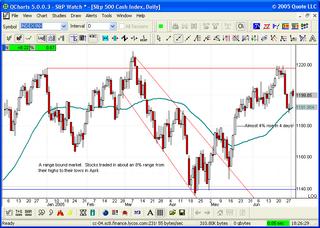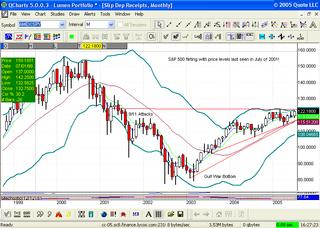2nd Quarter Letter to Clients.

Note. This is the complete text copy of the investment letter that is going to clients this week with their mid-year portfolio summaries.
Frustrating is perhaps the best way to describe the markets through June of 2005. Stocks have spent most of the last 18 months endeavoring to go nowhere and continued their sideways consolidation of 2003’s gains which we have previously documented. We have included a chart of the S&P 500 {SPX} which shows it’s choppy performance this year. Please note that the red horizontal line shows where the SPX began 2005. Through June all of the major averages had posted negative returns. The technology heavy Nasdaq posted the worst results being down a bit over 5%. The Dow Jones Industrial Average lost about 4% and the SPX 500 lost just a shade over 1%. Only smaller companies have out performed during this time. Analyst estimate that the average stock lost 5.5% through June 30th .
The choppy nature of the market has placed us in a more defensive position these past 18 months. Among other things we have carried larger cash positions commensurate with client risk during this time in order to minimize some of the downside and some of the market’s volatility. Yet at this time our thinking on stocks is undergoing a sea change. Our work is telling us that based on current information the market is undergoing a subtle yet profound change in character. It is our belief that we are entering a period of market transformation that will bring equities back into vogue. We feel that the pieces are in place for a sea change which has the possibility of giving us above average appreciation over the next 6-18 months.
Please remember that what follows is not our thesis about today or tomorrow but for the next 6-18 months. We are simply stating our current investment thinking and deriving certain probabilities based on the facts as we see them at this time. Something could happen tomorrow that would make us rethink this whole process. It is not written in stone. If such a change comes about we are prepared to turn on a dime and adjust portfolios accordingly.
The corrective phase that we have recently witnessed is long by modern standards. Stocks in the main correct in one of two ways, time and price. Most larger stocks have stagnated during this time period. Any corrections that they have seen have tended to be shallow. At the same time corporate earnings have been strong and corporate balance sheets are in good condition. Each day that passes when stocks trend is a day in which their valuations contract.
The economy is in much better shape than most economists would have thought a year ago. As evidence note that the budget deficit is actually contracting versus estimates given at the beginning of the year. Lower growth in Europe & Asia could slow the US economy next year to around the historic GDP growth rate of 3%. If this occurs it should lead to a deceleration of inflation. There have also been the twin headwinds of rising interest rates and rising oil prices. Any indications that oil prices have peaked or that the Federal Reserve might stop raising of rates would be viewed as extremely positive by stocks. Irregardless, interest rates are likely to remain relatively low by historical standards.
However we believe that the issues most holding back stocks at this time is the extreme pessimism exhibited by investors towards equities. Let’s face the facts on stocks. Year 2000 up to now has been rough going with only 2003 showing strong positive results. Even last year’s fourth quarter rally was a chimera which proved to be little more than window dressing as stocks promptly gave back most of these gains between January and April. Otherwise, a 2 1/2 year equity meltdown, terrorism, wars in Iraq and Afghanistan, a Presidential election decided by the US Supreme Court plus corporate scandals are not an environment conducive to long term stock performance or investors perception that stocks are a good place for their money.
But a benign slow growth environment with some help next year from oil and the Federal Reserve should allow for market expansion. While investors have turned a general thumbs down towards equities, Corporate America has been buying back either their own stock or the shares of other companies. CNBC recently stated that corporations are buying back shares to the tune of 1.5 Billion dollars a day while corporate mergers and acquisitions have substantially accelerated, the most prominent example of this is Procter & Gamble's pending purchase of Gillette.
Now a caveat: Our more positive attitude comes with these cautions. While the market has experienced a fairly substantial rally since early April, we are entering a seasonally weak period for stocks. July through September are typically months where the market has traditionally been weak. Therefore it would not surprise us to see stocks slightly lower or flat from these levels by early fall. Again this may not happen this year but that is the seasonal pattern. The 2nd thing is that there are events that could derail this thesis. A major terrorist attack or some unexpected glitch in the economy would render these thoughts suspect. Investors are always worried about the consumer (we usually are not) but any evidence in consumer spending slow down could have a dampening effect on stock prices. Finally an unexpected price move in oil (i.e. oil at 100 dollars a barrel) could finally pose a substantial risk to economic growth.
All that being said, we are now more positive on equities than we have been since the spring of 2003. It is not clear if this will happen in a short violent upward thrust or whether it will be something that occurs gently over a period of months but the conditions are more favorable now for growth than they have been in quite a long time. We are therefore in the process of becoming more aggressive for accounts based on their investment parameters and risk profiles. Areas of concentration at this time should be technology, biotech, medical, retail and financial shares once evidence shows up that the Federal Reserve is done raising interest rates. Much of this exposure can and will be bought in accounts using exchange traded funds.
The sea change we are talking about is mostly in psychology. Since early 2000 investors have grown accustomed to selling stock market rallies. If we are correct in our analysis, investors will soon prefer to “buy the dips”.






